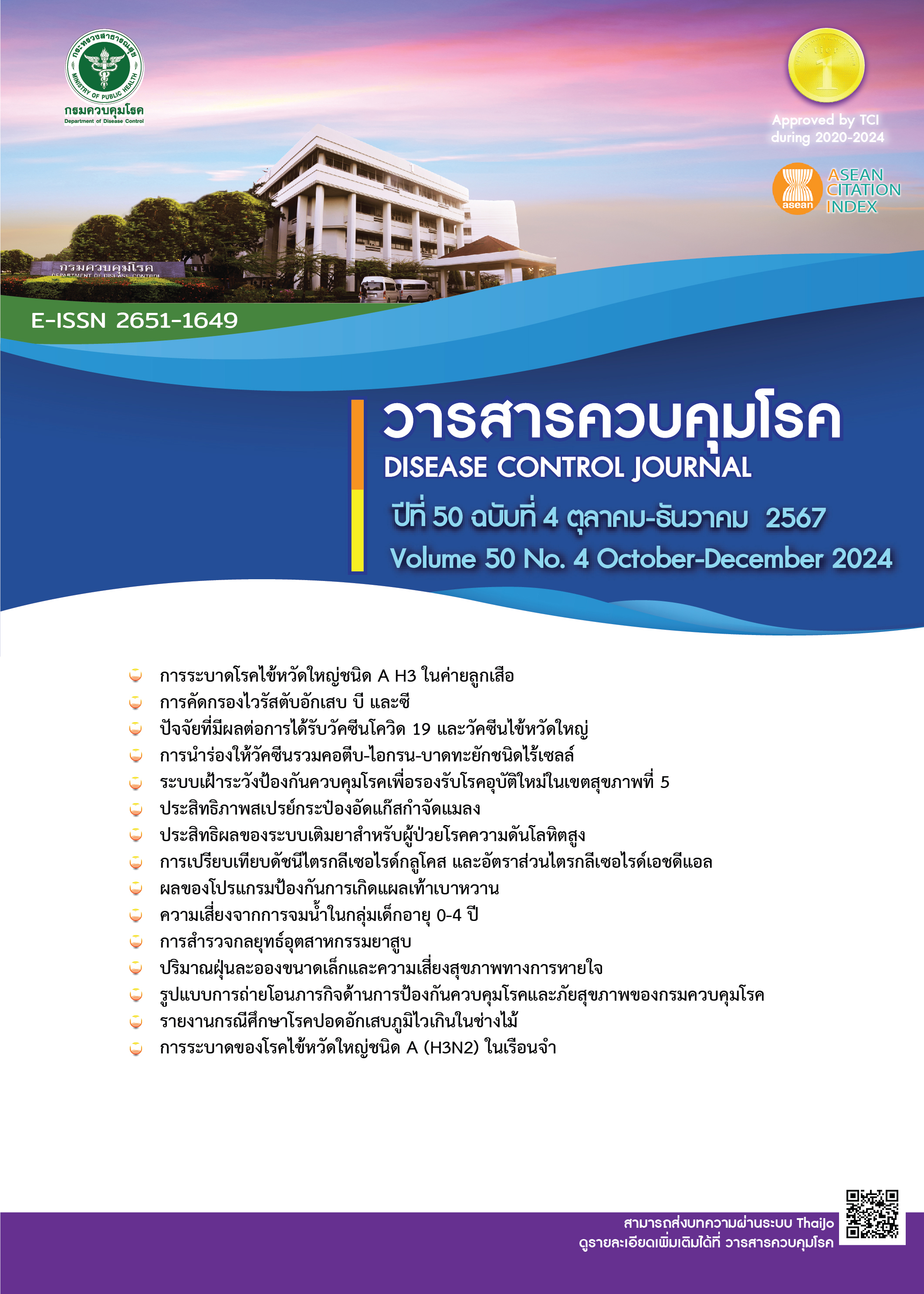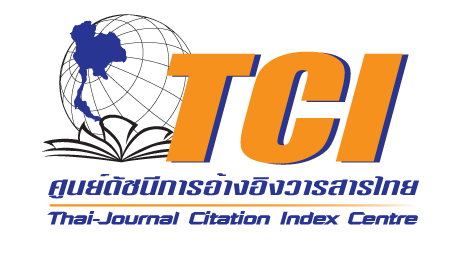การประเมินประสิทธิภาพสเปรย์กระป๋องอัดแก๊สกำจัดแมลง เพื่อเป็นตัวควบคุมผลบวกสำหรับทดสอบประสิทธิภาพชีววิเคราะห์ ต่อยุงลายบ้าน แมลงวันบ้านและแมลงสาบเยอรมัน
DOI:
https://doi.org/10.14456/dcj.2024.51คำสำคัญ:
สเปรย์กระป๋องอัดแก๊ส, ตัวควบคุมผลบวก, ประสิทธิภาพชีววิเคราะห์บทคัดย่อ
การควบคุมคุณภาพผลการทดสอบเป็นหนึ่งในการประกันคุณภาพการตรวจวิเคราะห์ทางห้องปฏิบัติการ เพื่อให้ผลการทดสอบที่ได้มีความถูกต้อง น่าเชื่อถือ การศึกษานี้มีวัตถุประสงค์เพื่อประเมินประสิทธิภาพสเปรย์กระป๋องอัดแก๊สกำจัดแมลง จำนวน 3 สูตร ได้แก่ สูตร A มีสารออกฤทธิ์ Cypermethrin 0.20% w/w และ Imiprothrin 0.15% w/w, สูตร B มีสารออกฤทธิ์ Cypermethrin 0.15% w/w, Imiprothrin 0.10% w/w และ Transfluthrin 0.10% w/w และสูตร C มีสารออกฤทธิ์ Cypermethrin 0.20% w/w, Imiprothrin 0.15% w/w, Transfluthrin 0.10% w/w และ d-Tetramethrin 0.10% w/w สำหรับนำไปใช้เป็นตัวควบคุมผลบวกในการทดสอบประสิทธิภาพชีววิเคราะห์ของผลิตภัณฑ์ตัวอย่างกำจัดแมลงกับแมลงทดสอบที่เป็นสายพันธุ์ห้องปฏิบัติการ คือยุงลายบ้านและแมลงวันบ้าน โดยวิธี Glass chamber method และแมลงสาบเยอรมัน โดยวิธี Surface contact method ผลการศึกษาพบว่าสเปรย์อัดแก๊สทั้ง 3 สูตรผ่านเกณฑ์การทดสอบ แมลงทดสอบทั้ง 3 ชนิดมีอัตราตายอยู่ระหว่าง 96.67-100% และไม่พบความแตกต่างกันในอัตราการตายของกลุ่มแมลงแต่ละชนิดอย่างมีนัยสำคัญทางสถิติสรุปได้ว่า ทั้ง 3 สูตรที่ทดสอบมีประสิทธิภาพที่ใกล้เคียงกัน แต่สูตร A ประกอบด้วยสารออกฤทธิ์เพียง 2 ชนิด จึงสะดวกในการเตรียมมากกว่าสูตร B และ C เมื่อนำสูตร A ทดสอบกับแมลงทั้งสามชนิด จำนวน 10 รุ่นพบว่ายุงลายบ้านมีอัตราตายเฉลี่ยร้อยละ 100 แมลงวันบ้านมีอัตราตายเฉลี่ยร้อยละ 98.50 (SD=2.14) และแมลงสาบเยอรมันมีอัตราตายเฉลี่ยร้อยละ 100 ดังนั้น สูตร A จึงมีคุณสมบัติเหมาะสมมากที่สุดในการนำไปใช้เป็นตัวควบคุมผลบวกในการทดสอบประสิทธิภาพชีววิเคราะห์ผลิตภัณฑ์ตัวอย่างเคมีกำจัดแมลงเพื่อเปรียบเทียบและยืนยันความถูกต้องของผลการทดสอบที่ได้จากห้องปฏิบัติการ การประกันคุณภาพผลการทดสอบทำให้ลูกค้ามีความมั่นใจมากขึ้นในรายงานผลการทดสอบที่จะนำไปขึ้นทะเบียนผลิตภัณฑ์กับสำนักงานคณะกรรมการอาหารและยาเพื่อวางจำหน่าย
Downloads
References
Chareonviriyaphap T, Bangs MJ, Suwonkerd W, Kongmee M, Corbel V, Ngoen-Klan R. Review of insecticide resistance and behavioral avoidance of vectors of human diseases in Thailand. Parasit Vectors 2013;6:280-308.
Paeporn P, Sathantriphop S, Ya-umphan P, Mukkhun P, Tassanai P, Tonopas A. Bioefficiency test of aerosol insecticide products against a dengue vector, Aedes aegypti. JHS 2021; 30(1):162-8. (in Thai)
Ya-umphan P, Sathantriphop S, Mukkhun P, Suphapathom K. Bioefficiency of aerosol insecticide products against cockroaches. JHS 2012;21(3):513-20. (in Thai)
Food and Drug Administration (TH). Hazardous Substances. What is Hazardous Substances? [Internet]. [cited 2024 Aug 25]. Available from https://en.fda.moph.go.th/entrepreneurs-hazardous-substances/category/what-is-hazardous-substances/
Petersen EJ, Nguyen A, Brown J, Elliott JT, Clippinger A, Gordon J, et al. Characteristics to consider when selecting a positive control material for an in vitro assay. ALTEX 2021;38(2):365-76.
World Health Organization (WHO). Pesticides and their application for the control of vectors and pests of public health importance [Internet]. 2006 [cited 2024 Aug 20]. Available from: https://apps.who.int/iris/handle/10665/ 69223
Department of Medical Sciences (TH), National Institute of Health (NIH). Sampling and service manual [Internet]. 2024 [cited 2024 Aug 25]. Available from https://nih.dmsc.moph.go.th/lab_nih/Apr2024.pdf
Chansuvarn W. Active Learning: Learning for all-Method validation [Internet]. 2021 [cited 2024 Nov 3]. Available from https://web.rmutp.ac.th/woravith/?page_id=8366#A2 (in Thai)
International Organization for Standardization. ISO/IEC 17025:2017: General requirements for the competence of testing and calibration laboratories. 3rd ed. Geneva: International Organization for Standardization; 2017.
Tanunkat A, Sinthusarn C. Process development for laboratory accreditation of public health laboratory according to ISO/IEC 17025: 2005. Bull Depart Sci 2013;55(4):197-213. (in Thai)
Ogoma SB, Mmando AS, Swai JK, Horstmann S, Malone D, Killeen GF. A low technology emanator treated with the volatile pyrethroid transfluthrin confers long term protection against outdoor biting vectors of lymphatic filariasis, arboviruses and malaria. PLOS Negl Trop Dis 2017;11:e0005455.
Ritchie SA, Montgomery BL, Walsh ID, Long SA, Hart AJ. Efficacy of an aerosol surface spray against container-breeding Aedes. J Am Mosq Control Assoc 2001;17(2):147-9.
Chueamsamakhi K. Guidelines for registration of the household aerosol insecticide products containing combinations of pyrethroids [Internet]. 2023 [cited 2024 May 5]. Available from: https://plan.fda.moph.go.th/media.php?id=587497779006414848&name=binder19313.pdf. (in Thai)
Bowman NM, Akialis K, Cave G, Barrera R, Apperson CS, Meshnick SR. Pyrethroid insecticides maintain repellent effect on knock-down resistant populations of Aedes aegypti mosquitoes. PLoS One 2018;3:e0196410.
Rozendaal JA. Vector Control: Methods for use by individuals and communities. World Health Organization. Geneva; 1997.
Kaewkaen K, Uttama S, Ruengsirarak W, Kaewkaen P. Test-retest reliability of the five times sit-to-stand test measured using the kinect in older adults. J Assoc Med Sci 2019;52(2):138-44.
Downloads
เผยแพร่แล้ว
How to Cite
ฉบับ
บท
License
Copyright (c) 2024 วารสารควบคุมโรค

This work is licensed under a Creative Commons Attribution-NonCommercial-NoDerivatives 4.0 International License.
บทความที่ลงพิมพ์ในวารสารควบคุมโรค ถือว่าเป็นผลงานทางวิชาการหรือการวิจัย และวิเคราะห์ตลอดจนเป็นความเห็นส่วนตัวของผู้เขียน ไม่ใช่ความเห็นของกรมควบคุมโรค ประเทศไทย หรือกองบรรณาธิการแต่ประการใด ผู้เขียนจำต้องรับผิดชอบต่อบทความของตน


.png)



